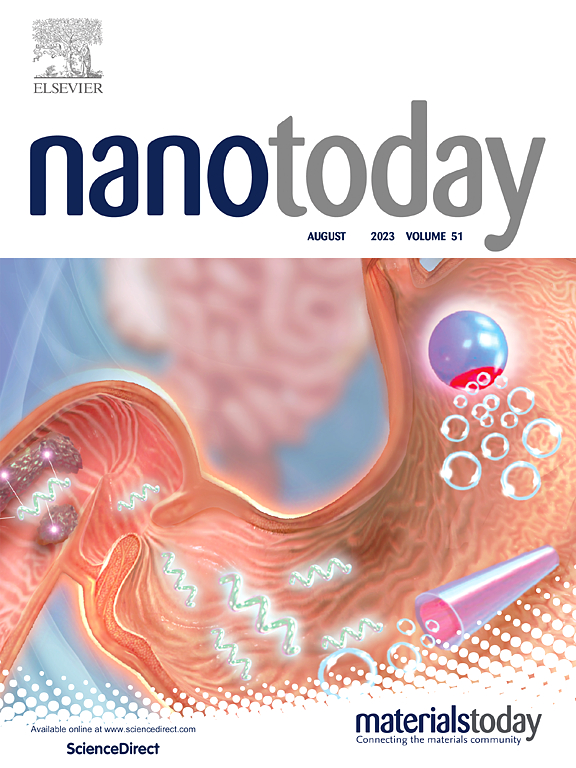Opposite synaptic plasticity in oxidation-layer-controlled 2D materials-based memristors for mimicking heterosynaptic plasticity
IF 10.9
1区 材料科学
Q1 CHEMISTRY, MULTIDISCIPLINARY
引用次数: 0
Abstract
Memristors with nonstoichiometric tungsten oxide (WOx) as an active layer, derived from the oxidation of atomically thin two-dimensional tungsten diselenide (WSe2), enable the creation of the monolithic layered structure of WOx/WSe2. These devices are promising candidates for emulating various biological synaptic functions in the human brain. In this study, we fabricate monolithic few-layer WOx/WSe2 memristors with precisely controlled WOx thickness by UV-ozone treatment from 1 L to 9 L, depending on chuck temperature. The postsynaptic responses of the topmost single-layer (1 L) oxidized WSe2 and fully (9 L) oxidized WSe2 memristors exhibit sharply contrasting behaviors, which can be applied to mimic the heterosynaptic plasticity in the CA1 region of the hippocampus. Beyond the significance of emulating the biological synaptic characteristics, we explore the feasibility of using each oxidation-layer-controlled memristor as a hardware accelerator. Their performances are assessed through application in a CIFAR-10 pattern recognition task using a convolutional neural network. Pattern recognition rates of 84 % and 71 % are obtained for the 1 L and 9 L WOx-based devices, respectively. We also examine the applicability of a synaptic cell composed of devices with oppositely switched characteristics. Consequently, the synaptic weight—defined as the difference in conductance between two synaptic devices—can be either increased (potentiated) or decreased (depressed) by simultaneously updating both devices with the same voltage signal. This weight update concept achieves a moderate recognition rate of 85.94 % when using an MNIST pattern-based recognition task, simplifying the complex weight-adjustment process.
氧化层控制二维材料忆阻器中的相反突触可塑性,用于模拟异突触可塑性
由原子薄二维二硒化钨(WSe2)氧化而成的非化学计量的氧化钨(WOx)作为活性层的晶闸管,能够形成 WOx/WSe2 的单片分层结构。这些器件有望模拟人脑中的各种生物突触功能。在本研究中,我们通过紫外线-臭氧处理,根据夹头温度的不同,制造出了单片几层 WOx/WSe2 记忆晶闸管,其 WOx 厚度可精确控制在 1 L 到 9 L 之间。最上层单层(1 L)氧化 WSe2 和完全(9 L)氧化 WSe2 记忆晶体的突触后反应表现出截然不同的行为,可用于模拟海马 CA1 区的异突触可塑性。除了模拟生物突触特性的意义之外,我们还探索了将每个氧化层控制的忆阻器用作硬件加速器的可行性。通过使用卷积神经网络在 CIFAR-10 模式识别任务中的应用,对它们的性能进行了评估。基于 1 L 和 9 L WOx 的器件的模式识别率分别为 84% 和 71%。我们还研究了由具有相反开关特性的器件组成的突触单元的适用性。因此,通过同时用相同的电压信号更新两个器件,可以增加(增强)或减少(抑制)突触权重,突触权重定义为两个突触器件之间的电导差。这种权重更新概念简化了复杂的权重调整过程,在使用基于 MNIST 模式的识别任务时,达到了 85.94% 的中等识别率。
本文章由计算机程序翻译,如有差异,请以英文原文为准。
求助全文
约1分钟内获得全文
求助全文
来源期刊

Nano Today
工程技术-材料科学:综合
CiteScore
21.50
自引率
3.40%
发文量
305
审稿时长
40 days
期刊介绍:
Nano Today is a journal dedicated to publishing influential and innovative work in the field of nanoscience and technology. It covers a wide range of subject areas including biomaterials, materials chemistry, materials science, chemistry, bioengineering, biochemistry, genetics and molecular biology, engineering, and nanotechnology. The journal considers articles that inform readers about the latest research, breakthroughs, and topical issues in these fields. It provides comprehensive coverage through a mixture of peer-reviewed articles, research news, and information on key developments. Nano Today is abstracted and indexed in Science Citation Index, Ei Compendex, Embase, Scopus, and INSPEC.
 求助内容:
求助内容: 应助结果提醒方式:
应助结果提醒方式:


